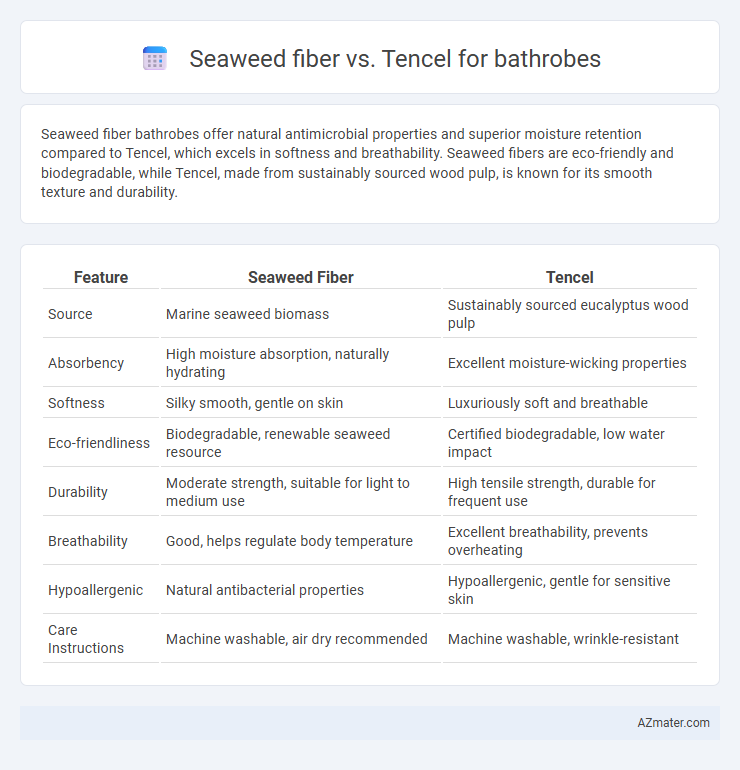Seaweed fiber bathrobes offer natural antimicrobial properties and superior moisture retention compared to Tencel, which excels in softness and breathability. Seaweed fibers are eco-friendly and biodegradable, while Tencel, made from sustainably sourced wood pulp, is known for its smooth texture and durability.
Table of Comparison
| Feature | Seaweed Fiber | Tencel |
|---|---|---|
| Source | Marine seaweed biomass | Sustainably sourced eucalyptus wood pulp |
| Absorbency | High moisture absorption, naturally hydrating | Excellent moisture-wicking properties |
| Softness | Silky smooth, gentle on skin | Luxuriously soft and breathable |
| Eco-friendliness | Biodegradable, renewable seaweed resource | Certified biodegradable, low water impact |
| Durability | Moderate strength, suitable for light to medium use | High tensile strength, durable for frequent use |
| Breathability | Good, helps regulate body temperature | Excellent breathability, prevents overheating |
| Hypoallergenic | Natural antibacterial properties | Hypoallergenic, gentle for sensitive skin |
| Care Instructions | Machine washable, air dry recommended | Machine washable, wrinkle-resistant |
Introduction to Bathrobe Fabrics: Seaweed Fiber vs Tencel
Seaweed fiber bathrobes offer natural antimicrobial properties and superior moisture retention, making them ideal for sensitive skin and eco-conscious consumers. Tencel, derived from sustainably sourced eucalyptus wood, boasts exceptional breathability and softness due to its lyocell fiber structure, ensuring comfort and durability. Both fabrics provide environmentally friendly alternatives to conventional cotton, with seaweed fiber excelling in skin nourishment and Tencel leading in fabric strength and moisture management.
Overview: What is Seaweed Fiber?
Seaweed fiber is an innovative sustainable textile derived from marine seaweed, particularly known for its natural antibacterial and moisture-wicking properties. This eco-friendly material is rich in minerals and biodegradable, making it an excellent alternative to traditional fibers in bathrobes, offering a soft, breathable, and skin-soothing experience. Compared to Tencel, which is made from sustainably sourced wood pulp, seaweed fiber provides added benefits such as enhanced detoxifying effects and antimicrobial protection.
What is Tencel? Origins and Properties
Tencel is a brand name for lyocell and modal fibers, derived from sustainably sourced wood pulp, primarily eucalyptus trees. Originating from Austria, Tencel is known for its eco-friendly closed-loop production process that recycles water and solvents, minimizing environmental impact. Its properties include exceptional softness, breathability, moisture-wicking ability, and durability, making it an ideal fabric choice for bathrobes.
Softness and Comfort: Seaweed Fiber vs Tencel
Seaweed fiber bathrobes offer exceptional softness with natural moisture-wicking properties, enhancing comfort by keeping skin hydrated and breathable. Tencel, derived from eucalyptus wood pulp, provides a silky-smooth texture that feels cool against the skin and is highly breathable, making it ideal for sensitive skin. Both fibers excel in softness and comfort, with seaweed fiber emphasizing skin nourishment and Tencel delivering a luxurious, airy feel.
Moisture Absorption and Breathability
Seaweed fiber exhibits excellent moisture absorption due to its natural hydrophilic properties, making it highly effective at wicking sweat away from the skin in bathrobes. Tencel, derived from sustainably sourced wood pulp, offers superior breathability through its smooth fiber structure, promoting air circulation and preventing overheating. Both fibers enhance comfort in bathrobes by combining moisture management with breathable fabric technology.
Antibacterial and Skin-Friendly Qualities
Seaweed fiber exhibits natural antibacterial properties due to its bioactive compounds, making it highly effective in reducing odor and preventing bacterial growth in bathrobes. Tencel, derived from sustainably sourced eucalyptus, is known for its exceptional skin-friendliness with a smooth, hypoallergenic texture that minimizes irritation and moisture retention. Both fibers offer excellent breathability and moisture-wicking abilities, enhancing comfort while maintaining hygiene in bathrobes.
Environmental Impact and Sustainability
Seaweed fiber for bathrobes offers significant environmental benefits due to its renewable source and biodegradability, reducing ocean pollution and supporting marine ecosystems. Tencel, derived from sustainably managed eucalyptus trees, utilizes a closed-loop production process that recycles water and solvents, minimizing waste and energy consumption. Both fibers contribute to sustainable fashion, but seaweed fiber stands out for its direct oceanic environmental impact, while Tencel emphasizes forest conservation and low-impact manufacturing.
Durability and Care Requirements
Seaweed fiber bathrobes offer moderate durability with natural antimicrobial properties but require gentle washing to maintain fabric integrity. Tencel bathrobes exhibit higher durability due to their strong lyocell fibers and resist shrinking or pilling, making them easier to care for with machine washability. Choosing between seaweed fiber and Tencel depends on balancing eco-friendly antimicrobial benefits with practical durability and low-maintenance care.
Cost and Availability Comparison
Seaweed fiber bathrobes generally come at a higher price point due to the niche production process and limited suppliers, whereas Tencel bathrobes benefit from more established manufacturing and wider availability, leading to more competitive pricing. Availability of seaweed fiber is constrained by the sustainability of harvesting and processing methods, making it less accessible globally compared to Tencel, which is mass-produced from sustainably sourced wood pulp. Consequently, consumers seeking affordable and readily available bathrobes often prefer Tencel over seaweed fiber options.
Choosing the Best Bathrobe: Seaweed Fiber vs Tencel
Seaweed fiber bathrobes offer natural antibacterial properties, excellent moisture absorption, and eco-friendly sustainability from renewable marine plants, making them ideal for sensitive skin and humid climates. Tencel bathrobes, derived from sustainably sourced eucalyptus wood, provide exceptional softness, breathability, and durability with moisture-wicking capabilities, suited for those seeking a silky texture and easy care. Choosing the best bathrobe depends on prioritizing either seaweed fiber's enhanced skin benefits and environmental impact or Tencel's luxurious feel and versatile performance.

Infographic: Seaweed fiber vs Tencel for Bathrobe
 azmater.com
azmater.com